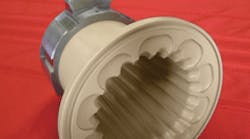High-intensity neutron source keeps cool with PEEK jacket
Resources: AIN Plastics, a division of ThyssenKrupp Materials NA Inc., www.ainplastics.com American Industrial Plastics Inc., www.aipdaytona.com Ensinger Inc., www.ensinger-online.com Oak Ridge National Lab Spallation Neutron Source, neutrons.ornl.gov Victrex plc, www.victrex.com/ |
A high-energy plasma neutron-beam source developed at Oak Ridge National Laboratory (ORNL), Oak Ridge, Tenn., traded in its two-part cooling jacket for a single-part alternative designed at Ensinger Inc., Washington, Pa.
The cooling jacket had to resist X-ray radiation and reduction by hydrogen, and it needed low radio-frequency (RF) losses and dimensional stability under pressure. Most importantly, it needed low thermal conductivity to help keep the ion plasma from overheating.
“The plasma puts a nominal 3-kW heat load on the plasma chamber,” said Robert Welton of ORNL’s Spallation Neutron Source (SNS) project. “The cooling jacket cools the plasma chamber by channeling water around it.”
The original cooling jacket was a two-part design made with polycarbonate (PC). The PC part needed extensive machining, which added internal stress and ultimately contributed to cracking and poor fit.
Ensinger, in consultation with its distributor AIN Plastics, a division of ThyssenKrupp, developed a one-part jacket that replaced PC with extruded Tecapeek. The polyetheretherketone (PEEK) raw material comes from Victrex plc, Thornton Cleveleys, Lancashire, U. K. American Industrial Plastics (AIP),
Daytona Beach, Fla., precision machined the jacket to within ±0.001 in.
The PEEK material met SNS’s thermal conductivity, dimensional stability, radiation resistance, and RF loss requirements. Precision machining gave it tighter dimensional tolerances with less residual internal stress.
The jacket surrounds a 3-in.-diameter, 7-in.-long aluminum-nitride plasma chamber. An RF-driven multicusp ion source in the chamber generates negatively charged hydrogen ions — hydrogen nuclei with two electrons — at 2.5 MeV. The ions are further accelerated to 1 GeV, stripped of their electrons, and collected in an accumulator ring that releases them in pulses at a frequency of 60 Hz.
Pulses impinge on a liquid mercury target, causing it to release, or spall off, neutrons. Mercury has an average of 120 neutrons/atom so it can be an efficient source of neutrons. In addition, mercury is not damaged by radiation. And because it is a liquid, mercury dissipates the shock of rapid high-energy pulses better than solids can.
Neutrons coming out of the target are directed down one of 18 paths to be used in various scientific instruments such as reflectometers, diffractometers, and spectrometers. On the way to each instrument, the pulses pass through water-filled or liquid-nitrogen-filled cells to turn them into room-temperature or cold neutrons, respectively.
Even after moderation, the neutron beams have 20 to 100 times the power of those from continuous ion sources. “Just as we prefer a bright light to a dim one to read the fine print in a book, SNS gives researchers more detailed snapshots of even the smallest samples of physical and biological materials,” explains Welton.
Neutrons help scientists detect the lowest-atomic-weight atoms in a material sample. For example, they help document the structure of therapeutic drug molecules by locating the hydrogen atoms. Neutrons scattered from hydrogen in water locate signs of microscopic cracking and early corrosion in fighter jet wings. And they locate oxygen atoms in yttrium-barium-copper oxide (YBCO) to determine the crystal structure that forms the best high-temperature, superconducting ceramic.
About the Author
Jessica Shapiro
Jessica serves as Associate Editor - 3 years service, M.S. Mechanical Engineering, Drexel University.
Work experience: Materials engineer, The Boeing Company; Primary editor for mechanical and fastening & joining.
